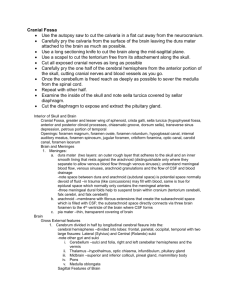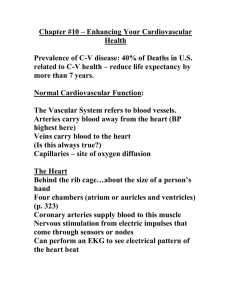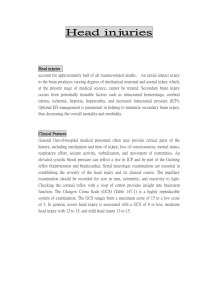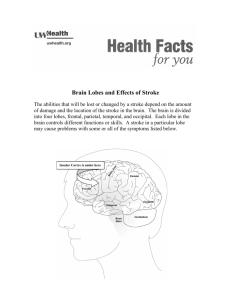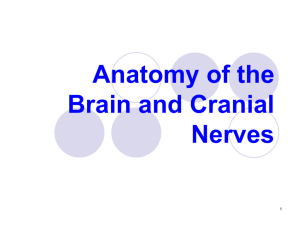CNS Pathology - El Camino College
advertisement
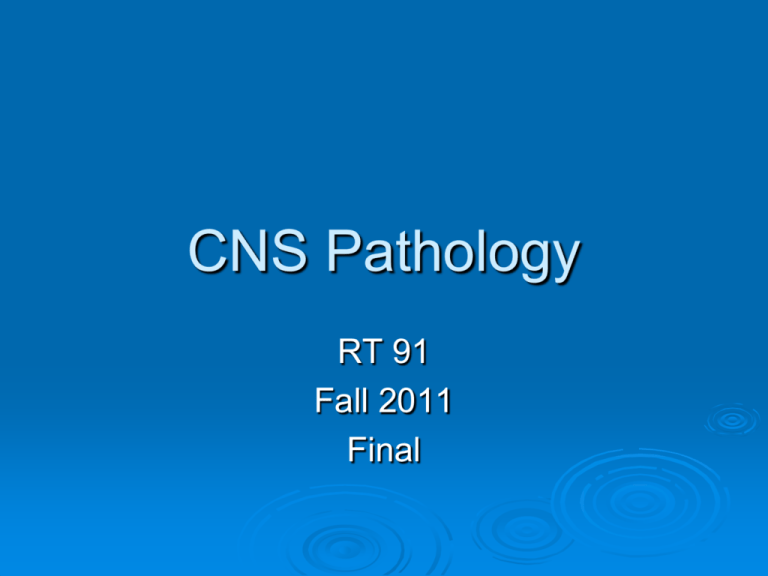
CNS Pathology RT 91 Fall 2011 Final CRANIAL FRACTURES Cranial Fractures Cerebral fractures usually occurs to fractures of the calvaria of the skull 3 types of cranial fractures ____________- straight and sharply defined • Is 80% of all cranial fractures ____________- curvilinear density ____________- Air fluid levels are indicative • Hard to diagnosis radiographically Cranial Fractures Location of FX is more important that the extent of the FX If FX crosses artery a bleed can occur causing a hematoma Fx that enters mastoid air cells or sinus can cause an infection that can result in • Meningitis • Encephalitis _______ Fractures Non branching lines that are intensely radiolucent Vascular markings are occasionally mistaken for fractures Fracture appears more translucent and transverses the full thickness of skull Sutures __________________ __________ Fracture The fractured edges ________ Usually caused by a high velocity impact with a small object Can cause bleeding into ______________ space Best demonstrated with CR __________to the FX _____________ Skull FX _______________Fracture Very difficult to demonstrate with x-ray __________________ in sphenoid sinuses Clouding of ________________________________ Often X-table lateral is done to demonstrate this CT & MRI are most often used for this type TRAUMATIC DISEASE Has protective membranes that enclose the brain and spinal cord Dura Mater- outer most layer • Tough and fibrous Arachnoid = middle layer • Has appearance of cobwebs Pia mater = innermost layer • highly vascular and closely adhered to cortex and spinal cord Subarachnoid space = wide space between arachnoid and pia mater • Filled with CSF • Bathes brain & spinal cord with nutrients • Cushions against shocks and blows Meninges Meninges Diagram Four irregular interconnected- fluidcontaining cavities Cerebrospinal fluid (CSF) = tissue fluid of the brain and spinal cord that surrounds and cushions CNS Ventricles communicate with each other through connecting channels Lateral ventricles = one on each side of MSP in corresponding hemispheres of cerebrum Ventricular System Interventricular foramen = connects lateral ventricles to third ventricle Also called foramen of Monroe Third ventricle is slitlike cavity somewhat quadrilateral in shape Situated in MSP, just inferior to lateral ventricles Cerebral aqueduct = connects third and fourth ventricle; also called aqueduct of Sylvius Ventricular System Cerebral ______________ Is an injury to the brain tissue caused by a ____________ of the brain within the calvaria after ______________________ Occurs when brain contacts rough skull surfaces such as _______&___________ PT usually loses consciousness and cannot remember traumatic event Persitent LOC over 24 hrs is a coma and can be fatal Cerebral Contusion Treatment: PT is hospitalized • Prevent shock Clinical symptoms: Drowsiness Confusion Agitiation Hemiparesis Unequal pupil size If there is swelling medication is given to decrease cranial pressure • Control edema • Draniage of hematoma Surgery is usually not necessary Cerebral ________________ Hematomas Brain trauma often resulting in a hemorrhaging from a ruptured ______________________ __________bleeding occurs more slowly than arterial bleeding _________bleed accumulates fast & causes neurologic symptoms & coma Both can cause edema in the brain and cause an increase in intracranial pressure Skull does not allow for expansion and pressure forces brain toward open space (foramen magnum) Can result in major consequences & death if not treated quickly ______________Hematomas Highest mortality relate of the hematomas Results from a torn _________ and its branches Even when treated quickly mortality rate is 30% Most often occurs from a FX of the _______ bone 80% of cases conventional radiograph shows fracture Usually _______________ with blood pooling between bones of the skull & _______________ ____________Hematoma Usually a shift of midline Toward ________ side CT shows increased density Emergency surgical decompression is required to relieve cranial pressure _______________ Hematomas Between the __________&___________ Caused by blunt trauma to frontal or occipital lobes and can tear ____________________ Pushes brain away from skull across midline (including ventricles) _____________Hematoma Occurs more slowly Because it is a ________ Hemorrhage. On CT appears as a curvilinear area of I increased density on portions or all of the cerebral hemispheres ______________Hematomas Subacute In stage (up to several days) Appears on CT as a decreased density or isodense fluid collection chronic state (2-3 weeks) The surface of the hematoma becomes concave Delayed coma cn occur Symptoms of Hematomas Headaches Agitation Drowsiness Gradual radiograph deficits Treatment of Hematomas In small hematomas without inclination to rebleed Severe cases the hemorrhage is reabsorbed naturally no treatment is necessary Require surgical ligation Evacuation of hematoma to prevent herniation Less invasive treatment may include Drug therapy Intraventricular catheter to remove CSF, which may cause herniation Gunshot Wounds Gunshot Wound _______________ Can be _______________ or ________________ Refers to an excessive amount of fluid in the ventricles Two types _______________________________ • Interferes or blocks normal CSF circulation from the ventricles to the subarachnoid space _________________________________ • Poor absorption of the CSF by the arachnoid Villi Least common cause is from overproduction of CSF _________________________ Non-communicating Can be congenital Can be from tumor growth Trauma (hemorrhage) Inflammation Communicating Can come with increased cranial pressure Raised intrathoracic pressure impairing venous flow Inflammation from meningitis Subarachnoid hemorrhage Radiographic Appearance Generalized enlargement of the ventricular system PA radiograph can reveal separation of the ___________ CT clearly demonstrates ventricular dilatation MRI is more specific in demonstrating the underlying cause of obstruction or in excluding obstruction Ultrasound is useful in utero and in infants Sound waves transverse open fontanels Hydrocephalus Hydrocephalus Hydrocephalus Clinical Symptoms The cranial size is enlarged Scalp veins distended Skin of scalp thin, fragile and shiny Neck muscles underdeveloped •In adults Severe cases •ALOC Orbital roofs are •Ataxia depressed •Incontinence Eyes displaced •Decreased intellectual downwards •capabilities Treatment of Hydrocephalus Placement of a ________ Internal jugular, heart or peritoneum Contains one way valve to prevent backflow of blood into ventricles Radiographs taken to verify _______________ CT or MRI done to evaluate success of treatment Hydrocephalus in Infants Affects 1 of every 1000 newborns Long maturation of CNS Can be caused by maternal & fetal infections, fetal hypoxia, irradiation, chemical agents and mechanical forces Vascular Disease ________________________ Is an atherosclerotic disease affecting blood supply to the brain ______________leading cause of death in U.S. 2 types of stroke: Both CT and MRI distinguish between the two types ___________________________________ MRI is especially sensitive to infarction within hours of onset CT, at times appears negative for a day or so Carotid duplex and MRA are also useful in the diagnosis of a stroke ________________ Stroke Blood clot blocks a blood vessel in the brain Is the majority of strokes Two types: ____________________ of cerebral artery • Blood clot that blocks a blood vessel ____________________ of the brain • Is a mass of undissolved matter (solid, liquid or gas) present in a blood vessel brought there by blood current Diagnosed with CT and MRI Angiography can be used if other modalites are questionable Symptoms of ________ __________Stroke Sypmtoms come on over horus to days Confusion Hemiplegia Aphasia May be preceded by a temporary episode of nerurologic dysfunction called transient ischemic attack (TIA) Includes hemiparesis, monocular blindness- clears up in about 2 hours Ischemic Stroke: from ______ ___________ onset of symptoms without warning Mortality rate is_______________ Prognosis depends on location, extent, age, and general health Complete recovery is rare Deficits remaining after 6 months are likely to be permanent Treatment Bed rest Clot blockers within 3 hours (recombinant tissue plasminogen activator (rtPA) Ischemic Stroke ________________ Stroke Occurs from a __________ in the diseased blood vessel Typically weakened from atheroscleosis from hypertension Sudden and often lethal because it comes on so suddenly Accounts for _____________of all CVA’s Two types: _______________-&___________________ Hemorrahgic Stroke Most occur in the ________ and bleed into lateral ventricle Most often preceded by an intense headache and vomiting LOC follows in minutes and leads to contralateral hemiplegia or death Prognosis is poor ___________ die day after stroke ___________die within a few weeks, usually from another vessel rupture Treatment of Hemorrahgic Strokes Surgery If Preceded by a surgical angiogram surgical intervention is postponed so will the angiogram Hemorrahgic Stroke Neoplastic Disease ___________ ____________ Pituitary Adenoma Acoustic Neuroma Acoustic Neuroma Metabolic Disease •X-ray of affected bones show cortical thickening with a coarse •Thickened trabecular pattern •Often called ___________ appearance •Mixed areas of ___________ &__________________ areas __________ __________ ________________Disease __________ Disease 1. _____________ disorder of unknown cause 2. Has two stages: 1. 2. _______________ _______________ 3. Fairly common in elderly 4. Affects men twice as frequently as women 54 Malignancy _________ ___________

